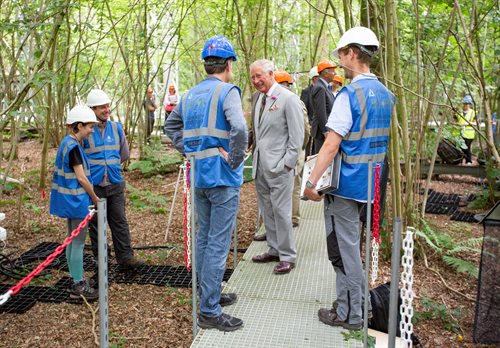HOLD the DATE: 30 and 31 January 2019, third annual BIFoR Community Meeting
The cold grasp of winter extended through February into mid-March this year. The ‘Beast from the East’ and ‘Mini Beast from the East’ brought below average temperatures and well above average snow-fall. Such conditions make field work challenging, but also offer new opportunities. Scott Hayward’s team identified which insect species had emerged early and how they coped with the unexpected return to winter conditions.
Continued cold into April delayed both bud burst and the emergence of many insect eaters, which resulted in millions of hungry caterpillars being perfectly synchronous with the first flush of oak leaves. Drone flights revealed the considerable extent of oak leaf loss. Such an extreme defoliation event has never been reported in any FACE experiment globally to date.
Warmer weather eventually arrived, resulting in a ‘top-3’ warmest and driest May, June, and July since 1910. Our ten-year study of the effects of elevated carbon dioxide on temperate broadleaf forest is helped enormously when the BIFoR FACE woodland is ‘exercised’ by such environmental extremes.
The first NERC £800k standard grant with substantial BIFoR FACE involvement focuses on how the forest litter layer changes in response to elevated carbon dioxide. This grant also marks our first collaboration with a European forest facility: the OH3P oak drought facility at Observatoire Haute Provence. Professor Dave Johnson from the University of Manchester will lead the project. We welcome such ambitious projects from colleagues in any institute.



Oak Bush-Cricket: a photo by BIFoR PhD student Liam Crowley, winner of Best Student Talk at the Royal Entomological Society Annual meeting: #ENTO2018
Funding Success
The Wolfson Foundation have generously pledged £1million towards the refurbishment of glasshouses on the University of Birmingham campus. This funding will enable us to pursue our research around tree disease and tree health.
Eager to use these facilities will be new BIFoR pathology experts Dr Estrella Luna-Diez and Dr Graeme Kettles.

James Levine, architect and atmospheric chemist, has won £62,400 of NERC Innovation funding to research the potential of green infrastructure to improve roadside air quality.

BIFoR PhD student, Anna Gardner successfully applied for a Royal Forestry Society Viking Bursary.

Seeing for themselves
We’re on track to exceed our 2017 total of 73 visits to the BIFoR FACE facility. Our list of visitors this year includes His Royal Highness Prince Charles, Lord Gardiner, the Parliamentary Under Secretary of State and Rural Affairs and Biosecurity, Tree Champion, Sir William Worsley; Professor Nicola Spence, the Chief Plant Health Officer for DEFRA. Please do contact us if you’d like to visit.

HRH Prince Charles & Lord Gardiner had a guided tour of the BIFoR FACE facility
Doctoral Researcher Summer Schools
Two summer schools introduced 60 international and national doctoral students to BIFoR FACE. The Central England NERC Training Alliance (CENTA) must have enjoyed their day: they’ve already booked for 2019!


Meet the new BIFoR doctoral researchers
Joining our team of 8 PhD students this academic year will be;
1. Ed Bannister, looking at environmental aerodynamics of the BIFoR FACE site.
2. Alex Kurawska, looking at the dynamics of tree growth in BIFoR FACE.
3. Thomas King, based at Lancaster University, looking at the ecophysiology of plant volatiles under elevated carbon dioxide.
4. Richard, Hill, Cotutelle/Dual Award based initially at EucFACE, University of Western Sydney.
We welcome our first cohort of 6 students to the Leverhulme Trust Forest Edge Doctoral Scholarship Programme. Recruitment to the 2019 cohort is open now!
1. Polly Jarman: Young people’s experiences of and learning in urban woodlands
2. Ben Howard: Coppice management to reduce nutrient loads in forest streams (with the Small Woods Association)
3. Jennifer Knight: Exploring the desirability of forest landscapes in a natural flood management context
4. Bridget Warren: Development and application of novel ecological and environmental proxies based leaf wax lipids
5. Ruben Foquet: Mangrove forest conservation and restoration: what are the keys to success?




Research Highlight
Native and introduced species respond differently to forest loss and fragmentation BIFoR ecologists Tom Matthews & Jon Sadler, working with colleagues from the Azores, used new surveys of bugs sampled in native forest fragments to test whether native species and introduced species respond differently to forest loss. The Azores has suffered extensive deforestation and fragmentation since human colonisation in the 15th Century. There have been a large number of non-native species introductions and island species extinctions.
Arthropods were sampled every three months for five years. It was found that the introduced species were frequently going locally extinct and re-colonising fragments from adjacent habitats (e.g. agricultural land). This implies that managing populations of non-native species only within native habitats may not be successful. A better management strategy would be to make the boundaries between native forest and adjacent habitats harder for the bugs to cross.
Matthews T., Sadler J. Curvalho R., Nunes R, Borges P., (2018) Differential temporal beta‐diversity patterns of native and non‐native arthropod species in a fragmented native forest landscape (2018) Ecography, 41: 1–10, 2018, https://doi.org/10.1111/ecog.03812
Student Activism!
In 2017/2018 there were 870 hours of volunteering 3 students completed GOLD level (50 hours), 2 completed SILVER (30 hours) and 10 completed BRONZE (15 hours).
GOLD volunteer Sarah Sheehan, completed a summer placement: “Each day was unique and varied, enabling me to gain deep insights into the different components”
BIFoRBLOG: new and written by students for students: https://wordpress.com/view/biforuob.wordpress.com
Mathematics undergraduate Jenna Kelly undertook a NERC-funded Research Experience Placement during the summer, looking at air turbulence above the BIFoR FACE forest.